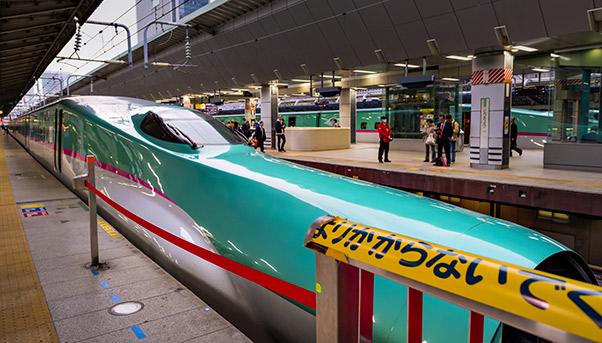A cross between technology and tradition, one of the symbols of Japan is the Shinkansen, the high-speed railway network with its bullet trains, known as “dangan ressha”.
Given the way it was developed, the Shinkansen is a unique service. The first line, the Tokaido Shinkansen, ran 515 kilometres between Tokyo and Osaka and had trains that travelled along the line in three hours and 10 minutes at 220 kilometres per hour. It was inaugurated in 1964 but the project dates back to the time of Emperor Meiji in the early 1900s. The idea was to build a railway network with a narrow track gauge that could support steam trains travelling at 200 kilometres per hour. The network was to cross the sea and include Beijing and Singapore. The project was suspended in 1943 with the outbreak of war but the government had already bought the land and begun laying down tracks.
Thanks to the commitment of the head of the railway, Shinji Sogo, and engineer Hideo Shima, work began on April 20, 1959, and on Oct. 1, 1964, the first bullet train ran the “Tokaido Shinkansen”, the first high-speed railway line in the world that linked Tokyo, Yokohama, Nagoya, Kyoto and Osaka.
The Tokaido Shinkansen changed the travelling habits of the Japanese. In three years, it had served 100 million passengers and in 1976 it had exceeded one billion. Today, the average is more than 23,000 passengers per hour, making it the most travelled high-speed railway line in the world. This development has helped to give a boost to business, tourism and investment. In 1975, the Sanyo line was inaugurated, running from Okayama to Fukuoka. Then there was the Tohoku line and a third one called Joetsu. In the 1980s, the network was privatized and it has since come to cover the entire country. The last line, opened in March 2016, arrives at the extreme north of the country on the island of Hokkaido. In the coming years, it will be extended by 210 kilometres to reach Sapporo.
There is also the development of the Chuo line that will link Tokyo, Nagoya and Osaka in a mere hour despite the distance of more than 500 kilometres. This is thanks to the technology of magnetic levitation. The project is ready, with the first train having been shown to the public in 2015. In three years, the first section will open between Tofu and Sagamihara.

The line will use superconductor magnets and electrodynamic suspension that lifts the train at least 10 millimetres above the track to allow it to reach previously unthinkable speeds. In July 2015, the LO train series reached a record 603 kilometres per hour.
The expansion of the Shinkansen has gone in tandem with technological development, making it an emblem of progress that is unique in the world. The network is reserved to the high-speed trains because the rails have a gauge of 1,435 millimetres compared with the conventional 1,067. The trains have a minimum curve radius of 4,000 millimetres and go in a straight line, often through tunnels and across bridges. The traffic is regulated by an automated system that eliminates any possibility of human error.
The high-speed train are also reflects the country’s culture, highlighting such traits as punctuality, reliability, hospitality and tradition. The trains, which include a maximum of 16 cars and are 400 metres long, are very punctual. They always stop at the same spot so that travellers can wait in orderly lines on the platform and seat themselves very quickly after boarding. On average, a train stop at a station lasts no longer than 50 seconds. Even comfort and hospitality are sacred: the seats can rotate 180 degrees to make it easier to follow the motion of the train, while rigorous conductors wear white gloves and are at the service of every passenger.
The Shinkansen has had a very strong impact on the country’s economy. According to government figures, the high-speed trains have helped save at least 400 million hours in travel time and 500 million yen every year. What is more, the railway network has encouraged the growth of suburban centres, resolving problems associated with urbanization. The benefits in terms of road traffic and the environment are obvious. In fact, the Shinkansen trains have become the primary means of transportation in the country, superseding domestic air travel.


